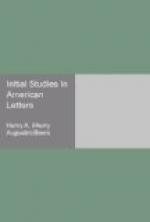At length, having reached the edge of the woods and shut out the gadding town, we enter within their covert as we go under the roof of a cottage, and cross its threshold, all ceiled and banked up with snow. They are glad and warm still, and as genial and cheery in winter as in summer. As we stand in the midst of the pines, in the flickering and checkered light which straggles but little way into their maze, we wonder if the towns have ever heard their simple story. It seems to us that no traveler has ever explored them, and notwithstanding the wonders which science is elsewhere revealing every day, who would not like to hear their annals? Our humble villages in the plain are their contribution. We borrow from the forest the boards which shelter and the sticks which warm us. How important is their evergreen to the winter, that portion of the summer which does not fade, the permanent year, the unwithered grass. Thus simply and with little expense of altitude is the surface of the earth diversified. What would human life be without forests, those natural cities? From the tops of mountains they appear like smooth-shaven lawns; yet whither shall we walk but in this taller grass?
In this glade covered with bushes of a year’s growth see how the silvery dust lies on every seared leaf and twig, deposited in such infinite and luxurious forms as by their very variety atone for the absence of color. Observe the tiny tracks of mice around every stem, and the triangular tracks of the rabbit. A pure elastic heaven hangs over all, as if the impurities of the summer sky, refined and shrunk by the chaste winter’s cold, had been winnowed by the heavens upon the earth.
Mature confounds her summer distinctions at this season. The heavens seem to be nearer the earth. The elements are less reserved and distinct. Water turns to ice; rain to snow. The day is but a Scandinavian night. The winter is an arctic summer.
How much more living is the life that is in nature, the furred life which still survives the stinging nights, and, from amidst fields and woods covered with frost and snow, sees the sun rise!
“The
foodless wilds
Pour forth their brown inhabitants.”
The gray squirrel and rabbit are brisk and playful in the remote glens, even on the morning of the cold Friday. Here is our Lapland and Labrador; and for our Esquimaux and Knistenaux, Dog-ribbed Indians, Novazemblaites, and Spitzbergeners, are there not the ice-cutter and wood-chopper, the fox, musk-rat, and mink?
Still, in the midst of the arctic day we may trace the summer to its retreats and sympathize with some contemporary life. Stretched over the brooks, in the midst of the frost-bound meadows, we may observe the submarine cottages of the caddice-worms, the larvae of the Plicipennes. Their small cylindrical cases built around themselves, composed of flags, sticks, grass, and withered leaves, shells and pebbles, inform




